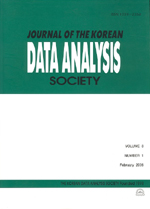형상의학에서 3차원 얼굴 데이터에 대한 통계적 방법 연구
Study on the Statistical Methods for the 3D Facial Data in the HyungSang Clinical Medicine - Focused on the Dam(gall bladder) and BangKwang(urinary bladder) Body
- 한국자료분석학회
- Journal of The Korean Data Analysis Society (JKDAS)
- Vol.10 No.3
-
2008.061327 - 1337 (11 pages)
- 7

본 연구에서는 3차원 얼굴 데이터를 이용하여 형상의학에서의 담-방광체 진단을 위한 통계적 방법을 다루고 있다. 3차원 데이터는 먼저 3차원 영상진단기를 이용하여 얼굴형상을 구현하고, 구현된 얼굴 위에 51개의 특징점을 포인팅하여 3차원 좌표를 얻은 다음, 변환 프로그램을 이용하여 각 점들간의 수직거리, 수평거리, 각도, 면적, 사선길이 등을 계산하여 총 332개의 분석변수를 얻게된다. 본 연구에 사용하는 데이터의 수집은 2008. 6. 9. - 2008. 6. 20 사이에 D대학교 부속 한방병원에서 시행한 임상시험에 참여한 남자 140명, 여자 160명 합계 300명의 3차원 얼굴 데이터이다. 진단정확률이 높은 담체-방광체의 형상진단함수를 구하기 위한 통계적 방법으로 평균값 차이에 대한 이표본 t-검정과 단계별판별분석, 그리고 선형판별분석을 이용하고 있다.
In this study, when a physician make a diagnosis of the Dam(gall bladder) and BangKwang(urinary bladder) body in the HyungSang medicine, the statistical methods for HyungSang classification function is considered by the 3D facial data. 3D data are collected as follows: Facial shapes are embodied by 3D facial scanner firstly. And 3D coordinates of 51 points are obtained by pointing the facial surface, the converting program is used for the transformation of analysis variables. Then the number of analysis variables are 332 items totally composed of height, breadth, angle, area, oblique line length.We analyze the 3D facial data of clinical trial for 300 cases totally composed of 140 men and 160 women who visited Dongeui University Oriental Medical Center from 9 June 2008 to 20 June 2008. In order to improve the diagnosis accuracy of classification function into the Dam and BangKwang body in the HyungSang medicine, we use the two-sample t-test, discriminant analysis and stepwise discriminant analysis.
1. 서론
2. 연구대상
3. 형상분류함수
4. 결론
참고문헌
(0)
(0)